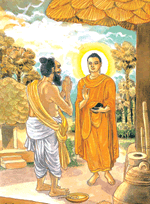Distinction on Mindfulness

Venerable Alawwe Anomadassi Thero presents a clear distinction between two methods of mindfulness, arguing that only one is truly productive in dismantling the self (sakkaya nirodha ˉ ). The Two Modes of Practice The sermon contrasts two approaches based on their immediate effectiveness versus their sustainability: Mindfulness with Intention ( manasik a ˉ ra ) and Focus: This practice is driven by a deliberate intent or focus, which makes it easier to sustain for longer periods . However, precisely because it is governed by an intentional 'doer,' it is considered less direct in bringing one closer to the Dhamma and the insight of non-self . Bare Awareness of What Occurs: This is the unforced, non-reactive observation of phenomena, which brings one closer to the Dhamma . Its challenge is that, lacking the deliberate anchor of manasik a ˉ ra , it is difficult to sustain for extended durations. The Superiority of Internal Engagement The true focus of the teaching is on the m...





